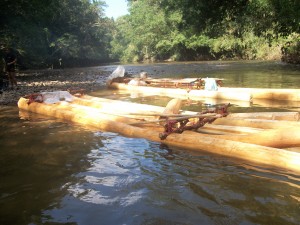Expedition Club More “Wired-In” & Amazon Dispatch
Club Expands Communications Services
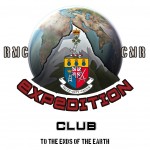 The RMCC Expedition Club made significant strides this week on its vision of equipping Canada’s future military leaders for complex conflicts with an array of leadership experiences in global settings. Raising the bar on its communications services, the Club has gone live with a new website and fresh social media engagement, including Twitter and Facebook.
The RMCC Expedition Club made significant strides this week on its vision of equipping Canada’s future military leaders for complex conflicts with an array of leadership experiences in global settings. Raising the bar on its communications services, the Club has gone live with a new website and fresh social media engagement, including Twitter and Facebook.
“Cadet expeditions are not only about the physical adventures, they offer academic accreditation and cultural research in sometimes complex, operational-like environments,” says the Club Director of Communications, 25881 OCdt (IV) Anthony Matlock. “Expeditions are multi-dimensional by their very nature, and with growing interest in the experiences, our communications should keep pace.”
“The virtual communications space – beyond keeping Officer Cadets informed – is providing the opportunity to engage an expanding network of international contacts throughout fields of venture capitalism, social entrepreneurship, adventure travel, smart humanitarianism, journalism, film production, student societies and government. So just as the on-campus club can be a tremendous resource for cadets wishing to sink their teeth into the challenges and complexities of certain regions around the world, the online community may well provide, over time, another form of engagement by cadets with like-minded individuals and supporters across Canada and around the world.”
Beyond technical training for upcoming expeditions, and in recognition of a complex world and the ever-evolving face of modern conflict, the cadet-driven club will also explore areas of strategic thinking, innovation and thought leadership in the 2012/13 academic year.
For cadets: young minds can help address age-old tensions – so think beyond, stay inspired and add value in the world!
_______________________
Amazon Expedition Dispatch: Journées 5 à 8
par 25842 OCdt (IV) Constance-Aurélie Ratelle
Une des parties prévues de notre voyage était de « survivre » pendant 5 jours dans la jungle. Notre était de marcher pour se rendre à une rivière, construire des radeaux pour descendre le long de cette rivière pendant deux jours puis revenir à « civilisation » la dernière journée. Évidemment, nous devions nous attendre à quelques surprises…
Day 1
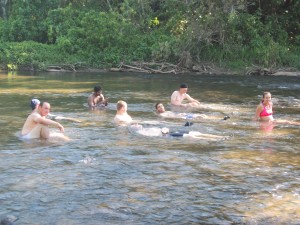 Couple hours of ruck march in the jungle, in the mountains with the brightest sun ever seen was what our schedule predicted for us and it is exactly what we got. Leaving from Misahualli we boated for an hour before reaching the starting point a little deck leading to a path. First to do when you are planning to go in the jungle : spray bug repellent everywhere, twice. We left the deck and started walking, and climbing, and walking, and walking… for 6 hours. When we finally got to the river, it was time to get the machetes out and start trimming all the trees and plants to make shelters for the night. We worked hard and got everything settled down, it was time to enjoy a brake and dinner. After a fulfilling (very fulfilling) meal, we went to bed. The second day was going to be the hardest one.
Couple hours of ruck march in the jungle, in the mountains with the brightest sun ever seen was what our schedule predicted for us and it is exactly what we got. Leaving from Misahualli we boated for an hour before reaching the starting point a little deck leading to a path. First to do when you are planning to go in the jungle : spray bug repellent everywhere, twice. We left the deck and started walking, and climbing, and walking, and walking… for 6 hours. When we finally got to the river, it was time to get the machetes out and start trimming all the trees and plants to make shelters for the night. We worked hard and got everything settled down, it was time to enjoy a brake and dinner. After a fulfilling (very fulfilling) meal, we went to bed. The second day was going to be the hardest one.
Jour 2
Après un bon déjeuner, nous sommes partis, avec les guides, à la recherche d’arbres balsas qui nous serviraient à construire les radeaux. Nous avons marché pendant 45 minutes, en plein milieu de la rivière, pour finalement trouver un petit îlot rempli de ces fameux arbres. Notre but pour la journée était d’abattre 30 feuillus, les peler et les attacher ensemble. De prime abord, cette tâche semble simple et assez facile, mais couper un arbre à la machette est beaucoup exigeant qu’on le croie, surtout lorsqu’il faut en abattre 30! Malgré la difficulté, nous avons atteint notre objectif sans problème. Une fois la coupe terminée nous avons descendu la rivière avec les troncs pour les assembler à notre campement. Il nous fallait tailler des « clous » pour tenir les troncs ensemble et les entailler sur la longueur pour rendre la surface antidérapante. Ceci nous a demandé encore quelques heures de travail, mais en fin de compte, nous avons réussi à construire quatre radeaux. Une fois la nuit tombée nous avons profité d’un bon repas bien mérité puis sommes allés nous coucher attendant la journée suivante où nous allions tester la solidité de nos embarcations.
Day 3-4
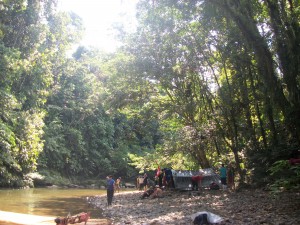 Expectations were that our rafts would fall apart or crash into rapids, but we worked hard to build good and solid rafts and the time had come to test them. We had four rafts so we split into small teams, 5 or 6 people per team plus 1 or 2 guides. The third and fourth days were the easiest ones. We only had to float down the river until we get to a sandy beach, set up camp, sleep and go back on the river. We peacefully enjoyed the amazing landscape, some of us jumped in the river holding onto lianas, just like in the movies.
Expectations were that our rafts would fall apart or crash into rapids, but we worked hard to build good and solid rafts and the time had come to test them. We had four rafts so we split into small teams, 5 or 6 people per team plus 1 or 2 guides. The third and fourth days were the easiest ones. We only had to float down the river until we get to a sandy beach, set up camp, sleep and go back on the river. We peacefully enjoyed the amazing landscape, some of us jumped in the river holding onto lianas, just like in the movies.
Il serait impossible d’écrire un article sur notre expérience dans la jungle sans mentionner les guides qui nous y ont accompagnés; Pépé, Paùl, Hornace, Fabio, Alejandro et un autre. « Jungle man ». Il n’y a pas d’autre mot pour décrire ces hommes. Ils connaissent la jungle, ils y sont nés, ils connaissent toutes les plantes, tous les animaux et leurs cris, tous les phénomènes qui s’y passent… C’est incroyable! Ils ont été pour nous une véritable encyclopédie, nous montrant comment construire des abris faits de feuilles de bananier, comment pêcher à mains nues, comment tresser des couronnes de feuilles, etc. D’ailleurs, pour ce qui est de la pêche, voici un exemple de ce que nous avons été capables d’attraper. Sans eux, nous n’aurions pas survécu, c’est certain.
Jour 5
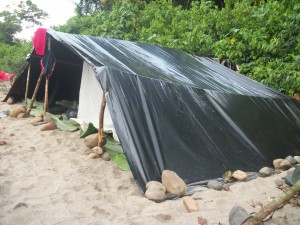 La dernière journée fut la plus longue de toute. Nous avions prévu marcher pendant 9 heures pour retourner à Misahualli, nous sommes donc partis vers 8h le matin. Le terrain montagneux rendait l’ascension et les descentes assez difficiles, mais de façon générale la marche s’est très bien déroulée. Nous suivions aveuglément les guides qui nous dirigeaient à travers la jungle et malgré tout, nous nous sommes perdus. Pour se diriger, les guides utilisaient les reliefs de la région. Nous devions atteindre une petite rivière, puis à partir de ce point continuer en ligne droite jusqu’au prochain point d’eau. Malheureusement pour nous le trajet « en ligne droite » s’est transformé en un trajet « en diagonale » à cause du relief montagneux du terrain. Nous avons tout de même retrouvé notre chemin facilement pour finalement rejoindre le camion qui allait nous ramener à la civilisation.
La dernière journée fut la plus longue de toute. Nous avions prévu marcher pendant 9 heures pour retourner à Misahualli, nous sommes donc partis vers 8h le matin. Le terrain montagneux rendait l’ascension et les descentes assez difficiles, mais de façon générale la marche s’est très bien déroulée. Nous suivions aveuglément les guides qui nous dirigeaient à travers la jungle et malgré tout, nous nous sommes perdus. Pour se diriger, les guides utilisaient les reliefs de la région. Nous devions atteindre une petite rivière, puis à partir de ce point continuer en ligne droite jusqu’au prochain point d’eau. Malheureusement pour nous le trajet « en ligne droite » s’est transformé en un trajet « en diagonale » à cause du relief montagneux du terrain. Nous avons tout de même retrouvé notre chemin facilement pour finalement rejoindre le camion qui allait nous ramener à la civilisation.
Those five days were very tiring but worth it. 20 people is a big group to walk in a trail and that did not allow us to observe any animals, but the trekking in itself was a great experience. The nature, the bugs, the sounds we could hear at night, everything was amazing. Pour tous ceux qui sont curieux de découvrir ce à quoi ressemble la jungle véritablement, c’est une expérience à tenter absolument!

